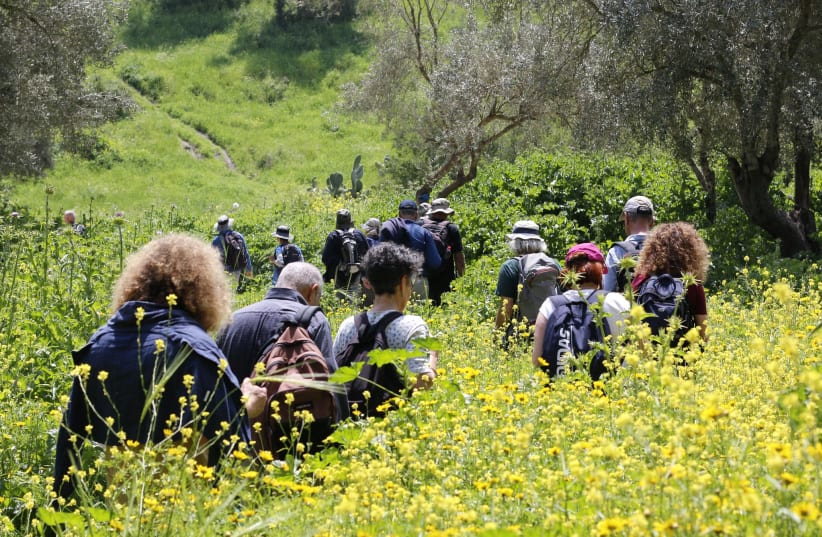According to Christian tradition, Jesus and his disciples did a lot of walking. Now pilgrims who want to walk in Jesus’s footsteps can do so on a new trail called the Emmaus Trail, which could be the road that Cleopas and another disciple walked from Jerusalem to Emmaus after the death of Jesus. According to the Gospel of Luke, as they walked they discussed the events that led to the crucifixion. At some point Jesus, who had been resurrected, appeared to them but they didn’t recognize him. When they arrived at Emmaus, which today is part of Ayalon Park near Latrun, they invited Jesus to stay the night with them. It was only then, when they sat and ate together, that they recognized him.
Pilgrims can walk the new 18-km. (11-mile) Emmaus Trail that now goes from the Saxum Visitor Center in Abu Ghosh, which has exhibits on Christianity, and ends at the monastery of Emmaus Nicopolis. The whole walk will take five to six hours.
The scenery is breathtaking with olive trees, almond trees and carpets of wildflowers. Along the path there are several tombs carved out of large boulders, with stone benches inside. A body would be laid out on the bench until only bones were left, and then the bones would be put in an ossuary.
Part of the route is a 2,000-year-old Roman road that connected Jerusalem with Jaffa’s seaport. The trail ends at the monastery of Emmaus Nicopolis, where there are extensive ruins of a Byzantine church. Groups of pilgrims still celebrate mass there.
“The Emmaus trail is a pilgrims’ trail. We don’t have this very much in Israel,” Henri Gourinard, a lecturer in historical geography who wrote a guidebook for the trail, told The Jerusalem Post. “There is the Gospel Trail in the Galilee, but the difference in the Emmaus Trail is you can do it in half a day. “It’s a nice way to end a pilgrimage and to meditate on before going back to your country.”
Right now in Israel, of course, there are no Christian pilgrims, who in 2019 made up more than half of the country’s 4.55 million tourists, according to the Tourism Ministry. But when they return, they will find new sites for them to visit, including a new wing of the Terra Sancta Museum in Jerusalem’s Old City.
The museum has a stunning collection of ritual objects made of gold and precious stones that were sent from various European countries to the Franciscan Church in Jerusalem.
“HERE IN JERUSALEM we are Christians from many denominations: Christians that are Latin as we are, Byzantine, Coptic, Armenian, Syriac, Ethiopian, many Protestants and so on. So everyone sees Jesus Christ with his own eyes, with his own culture, but the faith is the same,” said Father Stéphane Milovitch, liturgist, director of the Cultural Heritage Office, Custody of the Holy Land. “The culture can help the people through beauty to open their eyes and to see how other people see the same faith.”
He said he is disappointed that Jerusalem will not be able to host Christian pilgrims this year for Easter celebrations as Israel’s skies are still closed. But unlike last year when the Easter processions were canceled, this year they will be held and local Christians can participate.
Near the Terra Sancta Museum and Church, is the Casa Nova Guest House, one of six hotels for Christian pilgrims in Israel. Director Father Ibrahim Faltas said groups usually book three years in advance, but it has now been empty for an entire year. Faltas, who came to Jerusalem from Egypt in 1989, says the situation for tourists has never been this bad.
“I came during the First Intifada in 1989, and in the Second Intifada I was in Bethlehem during the siege [of the Church of the Nativity], but it was never like now,” he said. “During the First and Second Intifada there were a few pilgrims and tourists, but people came. This time it’s very difficult for everybody.”
Faltas said he kept the 60 workers at Casa Nova, most of whom come from the West Bank, on the payroll for as long as he could. In nearby Bethlehem, he said, people are suffering even more than in Israel. Almost all the Christians there work in tourism, and there is no funding for unpaid leave. He said he hopes tourists will come back soon.
Israel’s Tourism Ministry is ready when they do.
“This time, during the pandemic when we don’t have tourists is exactly the time that the Ministry of Tourism is doing renovations and adding new content to various sites,” Noga Sher-Greco, the religious tourism director at Israel’s Tourism Ministry, told the Post. “[Even when tourists return] tourism will not be like it was. There will be smaller groups and they will want to be out in the open air more. It means that even for people who have been here before, there will be new things for them to see.
